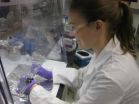(Press-News.org) COLUMBIA, Mo. April 17 – In the most densely forested and most densely populated quadrant of the United States, forests reflect two centuries of human needs, values and practices. Disturbances associated with those needs, such as logging and clearing forests for agriculture and development, have set the stage for management issues of considerable concern today, a U.S. Forest Service study reports.
The report – Five anthropogenic factors that will radically alter forest conditions and management needs in the Northern United States – was published recently by the journal Forest Science and is part of the Northern Forest Futures Project, an effort led by the Forest Service's Northern Research Station to forecast forest conditions over the next 50 years in the 20-state region extending from Maine to Minnesota and from Missouri to Maryland. The study is available at: http://www.nrs.fs.fed.us/pubs/45716
"In our research, we found five short- and long-term factors that will be highly influential regardless of the nature and magnitude of the effects of climate change," said lead author Stephen Shifley, a research forester with the Northern Research Station. "Addressing these issues today will make northern forests more resilient to the effects of climate change and to any other natural or anthropogenic disturbances in the long term."
The five factors identified the study are:
Northern forests lack age-class diversity and will uniformly grow old without management interventions or natural disturbances. Nearly 60 percent of northern forest land is clustered in age classes spanning 40 to 80 years; young forests (age 20 years or less) are only 8 percent of all forests in the region; and forests older than 100 years are 5 percent of forests.
The area of forest land in the North will decrease as a consequence of expanding urban areas. Cities in the 20-state region are expected to gain another 27 million people in the next 50 years and grow by about 5 million hectares.
Invasive species will alter forest density, diversity, and function. The U.S. North has the dubious distinction of having the greatest number of invasive insects and plants per county due to nearly three centuries of active commerce, diverse tree species that provide suitable habitats, and the means for invasive species to spread.
Management intensity for timber is low in Northern forests and likely to remain so. A low propensity or low capacity for forest management reduces options for addressing perceived problems such as low forest diversity, invasive species, and other insects or disease problems.
Management for non-timber objectives will gain relevance but will be challenging to implement. An unintended consequence of reduced timber harvesting may be reduced capacity to subsidize other restoration activities – either through revenue from timber sales or through manipulation of vegetation and woody fuels during logging.
Actions that researchers and land managers can take to address these issues include:
Develop quantifiable state and regional goals for forest diversity.
Understand the spatial and structural impacts of urban expansion on forests.
Develop symbiotic relationships among forest owners, forest managers, forest industry and the general public to support contemporary conservation goals.
Work to understand the many dimensions of forest change.
"The northern quadrant of the United States includes 172 million acres of forest land and 124 million people," said Michael T. Rains, Director of the Northern Research Station and the Forest Products Laboratory. "In the next 50 years, the link between forests and economic and human health will grow. The Northern Forest Futures Project is helping identify the individual and collective steps needed to ensure healthy and resilient futures for trees and people alike."
INFORMATION:
Co-authors on the study included Forest Service scientists Keith Moser, Dave Nowak, Pat Miles, Brett Butler, and Eric Greenfield; Francisco X. Aguilar of the University of Missouri, and Ryan DeSantis of the University of California Cooperative Extension.
The mission of the U.S. Forest Service is to sustain the health, diversity, and productivity of the nation's forests and grasslands to meet the needs of present and future generations. The agency has either a direct or indirect role in stewardship of about 80 percent of our nation's forests, amounting to 850 million acres including 100 million acres of urban forests gracing the nation's cities, where 80 percent of Americans live. The mission of the Forest Service's Northern Research Station is to improve people's lives and help sustain the natural resources in the Northeast and Midwest through leading-edge science and effective information delivery.
Five anthropogenic factors that will radically alter northern forests in 50 years
US Forest Service study suggests climate is not the only factor ushering in change
2014-04-17
ELSE PRESS RELEASES FROM THIS DATE:
CU researchers discover target for treating dengue fever
2014-04-17
AURORA, Colo. (April 17, 2014) – Two recent papers by a University of Colorado School of Medicine researcher and colleagues may help scientists develop treatments or vaccines for Dengue fever, West Nile virus, Yellow fever, Japanese encephalitis and other disease-causing flaviviruses.
Jeffrey S. Kieft, PhD, associate professor of biochemistry and molecular genetics at the School of Medicine and an early career scientist with the Howard Hughes Medical Institute, and colleagues recently published articles in the scholarly journals eLife and Science that explain how flaviviruses ...
Vitamin B3 might have been made in space, delivered to Earth by meteorites
2014-04-17
Ancient Earth might have had an extraterrestrial supply of vitamin B3 delivered by carbon-rich meteorites, according to a new analysis by NASA-funded researchers. The result supports a theory that the origin of life may have been assisted by a supply of key molecules created in space and brought to Earth by comet and meteor impacts.
"It is always difficult to put a value on the connection between meteorites and the origin of life; for example, earlier work has shown that vitamin B3 could have been produced non-biologically on ancient Earth, but it's possible that an added ...
Bright points in sun's atmosphere mark patterns deep in its interior
2014-04-17
Like a balloon bobbing along in the air while tied to a child's hand, a tracer has been found in the sun's atmosphere to help track the flow of material coursing underneath the sun's surface.
New research that uses data from NASA's Solar Dynamics Observatory, or SDO, to track bright points in the solar atmosphere and magnetic signatures on the sun's surface offers a way to probe the star's depths faster than ever before. The technique opens the door for near real-time mapping of the sun's roiling interior – movement that affects a wide range of events on the sun from ...
Lab researcher discovers the green in Greenland
2014-04-17
At one point in history, Greenland was actually green and not a country covered in ice.
An international team of researchers, including a scientist from Lawrence Livermore National Laboratory, has discovered that ancient dirt in Greenland was cryogenically frozen for millions of years under nearly two miles of ice.
More than 2.5 million years ago. Greenland looked like the green Alaskan tundra, before it was covered by the second largest body of ice on Earth.
The ancient dirt under the Greenland ice sheet helps to unravel an important mystery surrounding climate change: ...
Multitarget TB drug could treat other diseases, evade resistance
2014-04-17
CHAMPAIGN, Ill. — A drug under clinical trials to treat tuberculosis could be the basis for a class of broad-spectrum drugs that act against various bacteria, fungal infections and parasites, yet evade resistance, according to a study by University of Illinois chemists and collaborators.
Led by U. of I. chemistry professor Eric Oldfield, the team determined the different ways the drug SQ109 attacks the tuberculosis bacterium, how the drug can be tweaked to target other pathogens from yeast to malaria – and how targeting multiple pathways reduces the probability of pathogens ...
Study recalculates costs of combination vaccines
2014-04-17
CHAMPAIGN, Ill. — One of the most popular vaccine brands for children may not be the most cost-effective choice. And doctors may be overlooking some cost factors when choosing vaccines, driving the market toward what is actually a more expensive option, according to a new study by University of Illinois researchers.
"The choice of vaccines to administer can be driven by numerous factors," says Sheldon H. Jacobson, a co-author of the study and a professor of computer science and of mathematics at the U. of I. "In an environment where vaccines are under growing public scrutiny, ...
Feinstein Institute researcher publishes new perspective on sepsis
2014-04-17
MANHASSET, NY – In a review published in the April issue of Immunity, Kevin J. Tracey, MD, president of The Feinstein Institute for Medical Research, says it's time to take a fresh look at the medical community's approach to treating sepsis, which kills millions worldwide every year, including more than 200,000 Americans.
Sepsis occurs when molecules released into the bloodstream to fight an injury or infection trigger inflammation throughout the body. Inflammation is necessary for maintaining good health – without inflammation, wounds and infections would never be ...
McCullers reviews influenza, bacterial superinfections in Nature Reviews Microbiology
2014-04-17
Le Bonheur Children's Hospital Pediatrician-in-Chief Jon McCullers, MD, was recently invited to submit a review in the April issue of Nature Reviews Microbiology, one of the world's foremost scientific publications. Dr. McCullers, a world-renowned infectious disease specialist, and chair of the Department of Pediatrics at the University of Tennessee Health Science Center, analyzed the epidemiology and microbiology of co-infections during the 1918, 1957 and 1968 pandemics, as well as more recent 2009 novel H1N1 pandemic.
He reviewed the co-pathogenesis of influenza viruses ...
Building 'smart' cell-based therapies
2014-04-17
A Northwestern University synthetic biology team has created a new technology for modifying human cells to create programmable therapeutics that could travel the body and selectively target cancer and other sites of disease.
Engineering cell-based, biological devices that monitor and modify human physiology is a promising frontier in clinical synthetic biology. However, no existing technology enabled bioengineers to build such devices that sense a patient's physiological state and respond in a customized fashion.
"The project addressed a key gap in the synthetic biology ...
Live cell imaging reveals distinct alterations of subcellular glutathione potentials
2014-04-17
In the April issue of Experimental Biology and Medicine a multidisciplinary research team led by Drs. Rex Gaskins and Paul Kenis in the Institute of Genomic Biology (IGB) on the campus of the University of Illinois Urbana-Champaign describe their recent work on subcellular redox homeostasis. Intracellular reduction-oxidation reactions underlie a variety of cell functions including energy metabolism, signaling, and transcriptional processes. Due to these crucial roles in regulating normal cellular behavior, redox status has been recognized as a key area of biological research ...
LAST 30 PRESS RELEASES:
First Editorial of 2026: Resisting AI slop
Joint ground- and space-based observations reveal Saturn-mass rogue planet
Inheritable genetic variant offers protection against blood cancer risk and progression
Pigs settled Pacific islands alongside early human voyagers
A Coral reef’s daily pulse reshapes microbes in surrounding waters
EAST Tokamak experiments exceed plasma density limit, offering new approach to fusion ignition
Groundbreaking discovery reveals Africa’s oldest cremation pyre and complex ritual practices
First breathing ‘lung-on-chip’ developed using genetically identical cells
How people moved pigs across the Pacific
Interaction of climate change and human activity and its impact on plant diversity in Qinghai-Tibet plateau
From addressing uncertainty to national strategy: an interpretation of Professor Lim Siong Guan’s views
Clinical trials on AI language model use in digestive healthcare
Scientists improve robotic visual–inertial trajectory localization accuracy using cross-modal interaction and selection techniques
Correlation between cancer cachexia and immune-related adverse events in HCC
Human adipose tissue: a new source for functional organoids
Metro lines double as freight highways during off-peak hours, Beijing study shows
Biomedical functions and applications of nanomaterials in tumor diagnosis and treatment: perspectives from ophthalmic oncology
3D imaging unveils how passivation improves perovskite solar cell performance
Enriching framework Al sites in 8-membered rings of Cu-SSZ-39 zeolite to enhance low-temperature ammonia selective catalytic reduction performance
AI-powered RNA drug development: a new frontier in therapeutics
Decoupling the HOR enhancement on PtRu: Dynamically matching interfacial water to reaction coordinates
Sulfur isn’t poisonous when it synergistically acts with phosphine in olefins hydroformylation
URI researchers uncover molecular mechanisms behind speciation in corals
Chitin based carbon aerogel offers a cleaner way to store thermal energy
Tracing hidden sources of nitrate pollution in rapidly changing rural urban landscapes
Viruses on plastic pollution may quietly accelerate the spread of antibiotic resistance
Three UH Rainbow Babies & Children’s faculty elected to prestigious American Pediatric Society
Tunnel resilience models unveiled to aid post-earthquake recovery
Satellite communication systems: the future of 5G/6G connectivity
Space computing power networks: a new frontier for satellite technologies
[Press-News.org] Five anthropogenic factors that will radically alter northern forests in 50 yearsUS Forest Service study suggests climate is not the only factor ushering in change



